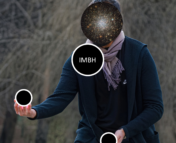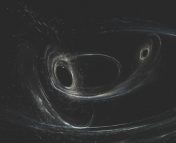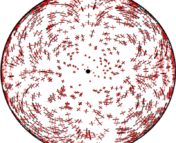Authors: Giacomo Fragione, Bence Kocsis, Frederic A. Rasio, Joseph Silk
First Author’s Institution: Northwestern University
Status: Published in the Astrophysical Journal [Open Access] (published March 10, 2022)
If black holes are like music artists, intermediate-mass black holes (IMBHs) are the indie hipster bands of the astronomy world. They may not grab the big headlines, but they dazzle their small group of hip, dedicated followers. To a music researcher, indie acts form the intriguing link between the myriad performances at high school talent shows and seedy bars and the rare few musicians who rise to fill stadiums and top billboard charts. Similarly, astronomers study IMBHs because they are the links connecting 1 M☉ objects (stars, stellar-mass black holes, etc.) to dazzling objects that are millions or billions of times more massive than the sun, like globular clusters, galaxies, and supermassive black holes (SMBHs), which we describe more in detail below.
But where to find the IMBH show?
Unlike stellar mass and supermassive black holes, evidence for the existence of IMBHs is still precarious despite multiple reports of potential detections. IMBHs are hard to spot because the gravitational and electromagnetic methods to observe stellar and supermassive black holes can’t easily spot IMBHs. IMBHs don’t have massive disks radiating light like some supermassive black holes, and they are too massive to be in the optimal frequency detection range of the LIGO-Virgo-Kagra gravitational wave detectors. Since IMBHs are so hard to detect, many astronomers, including today’s authors, have invested a lot of thought into understanding astrophysical interactions that predict how and where IMBHs might form and how we might observe them.
Performing on Stage 1 – Stars
The authors start with how individual stars can evolve into IMBHs. Only a tiny fraction of stars are massive enough to form black holes. Evidence suggests that the upper limit for the mass of a black hole formed from any single star is roughly 50 – 70 solar masses, with a notable exception being black holes formed from the first generation of massive stars in the early universe. Astronomers have postulated ways black holes more massive than this single-star limit can form. The most straightforward is for two stellar black holes to merge into a single, more massive one. For example, if both stars in a binary star system are massive enough to form black holes, one can imagine them eventually merging. This paper’s authors therefore build a model that includes 1) the proportion of total stars that are in binary systems and 2) how many of those stars are massive enough to form black holes.
Performing on Stage 2 – Dense Star Clusters
Next, the authors investigate how IMBHs can form in dense star clusters. Another way two stellar black holes can merge is if both stars become black holes independently (not as binary companions) and then find each other out in space. Because most stars are so far apart, black holes only collide this way in areas with extremely high numbers of stars in a small space. Nuclear star clusters at the centers of galaxies, which can have stellar populations a million times denser than our local solar system neighborhood, are one such place. The authors simulate these dense stellar clusters, focusing on how likely individual black holes in them are to run into each other.
Black hole harmonies
Furthermore, these two methods of black hole mergers can work together. Two stars in a binary system can become black holes, merge, and then run into a separate black hole and merge again. This process is called hierarchical merging. By combining the stellar and cluster models, this paper aims to predict the hierarchical merging rate of black holes, which tells us the overall mass distribution of black holes and whether they can grow big enough to be IMBHs.
Black hole dissonance
The authors include two complicating factors in their models – stellar metallicity and kicks. The upper bound of the black hole mass a single star can form depends on stellar metallicity because of metallicity’s impact on the pair-instability process.
There are two kinds of “kicks” that can prevent mergers – natal and recoil kicks. A natal kick happens when a star in a binary goes supernova, imparting a push onto the dying star, breaking the binary system, and preventing a merger. A recoil kick happens when the spins of two black holes are oriented such that, after a merger, the resulting black hole gets a massive speed boost so intense it is ejected from the dense cluster, preventing future mergers. In this video of two spinning tops moving around and colliding, notice how sometimes the spinning tops lightly tap and don’t move apart, and other times they touch and quickly snap apart. Recoil kicks are more complicated versions of this.
Figure 1 – Distribution of black hole masses for models with differing initial stellar metallicities. Z is the metallicity of the stars used in the model. For example, Z = 0.01 means 1% of the stars’ content is metals. Using lower metallicity stars results in a black hole distribution that is slightly more massive overall. The dotted and solid lines represent different cluster densities. The solid lines are from a denser nuclear star cluster model, while the dotted lines are from a less dense globular cluster. A dense nuclear cluster is required for black holes over a few hundred solar masses. From figure 3 (top) in the paper.
The Final Set
The authors run 17 “stellar evolution + dense star cluster” models, varying stellar metallicities, black hole spin models, the fraction of stars born as primordial massive stars, and cluster density. Figure 1 shows results for varying the stars’ metallicities and the star clusters’ density; the two factors they conclude have noticeable effects on the masses of the resultant black holes. Most importantly, their models show hierarchical merging can result in black holes in the intermediate mass range of around 103-104 solar masses, but only the densest nuclear star clusters have the properties to support hierarchical mergers. So, advice to a stellar-mass black hole that wants to strike it big: start by performing in a place packed with many stars and avoid playing metal!
Astrobite edited by: Lindsey Gordon and Abby Lee
Image Credit: credit: NASA/ESA + edits by Bill Smith




